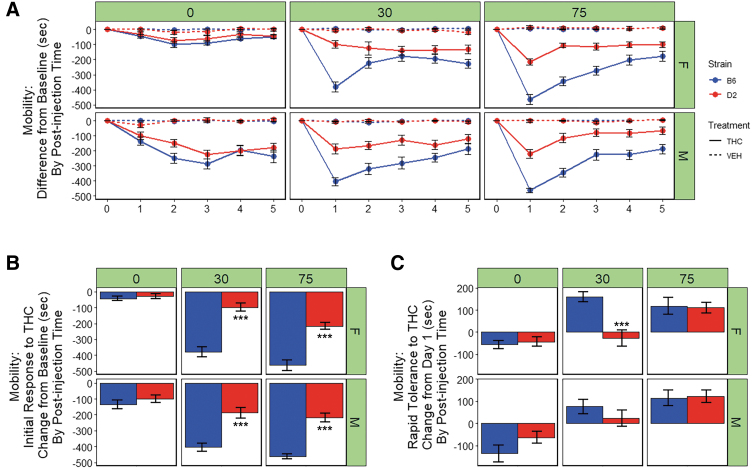FIG. 2.
Motor response to THC. (A) Time mobile in seconds (sec) in the open field is shown for B6 and D2 females (top panel) and males (bottom panel) at three time points (0, 30, or 75 min) post-injection of THC (10 mg/kg) or VEH. Trait data for every individual have been transformed relative to baseline (day 0) by subtracting trait values for each day by the trait values for day 0 and averaging data by strain, sex, treatment, day, and post-injection time. Data represented as mean±SEM. Ataxia is evident as early as 0–10 min (0-min time point) post-injection on day 1 and is more prominent in males. Peak initial response to THC occurs at 75 min post-injection on day 1. Both males and females of the B6 strain are more sensitive to the ataxic effects of THC relative to both sexes of the D2 strain, and males are more sensitive than females. Rapid tolerance is evident upon second exposure to THC and results in a modest ∼25% (B6) to ∼50% (D2) increase in motor activity. However, full desensitization (return to baseline levels) is not observed after five consecutive treatments. (B) Initial response to THC is shown as the difference between day 1 and 0 (baseline) for the THC treatment group (average of each individual's difference score, VEH group not shown). Significant strain differences in initial sensitivity to the ataxic effects of THC were evident on day 1 for both males and females at the 30 and 75 min post-injection time points based on Tukey's HSD test. (C) Rapid tolerance to THC is shown as the difference between day 2 and 1 (THC treatment group only). Rapid tolerance to the ataxic effects of THC is not evident at 0 min post-injection. Relative to D2 mice, B6 mice demonstrate significantly greater rapid tolerance to the ataxic effects of THC at 30 min post-injection. B6 females exhibited significantly greater rapid tolerance relative to D2 females at 30 min post-injection. Significance defined as p<0.05*, p<0.01**, and p<0.001***.

